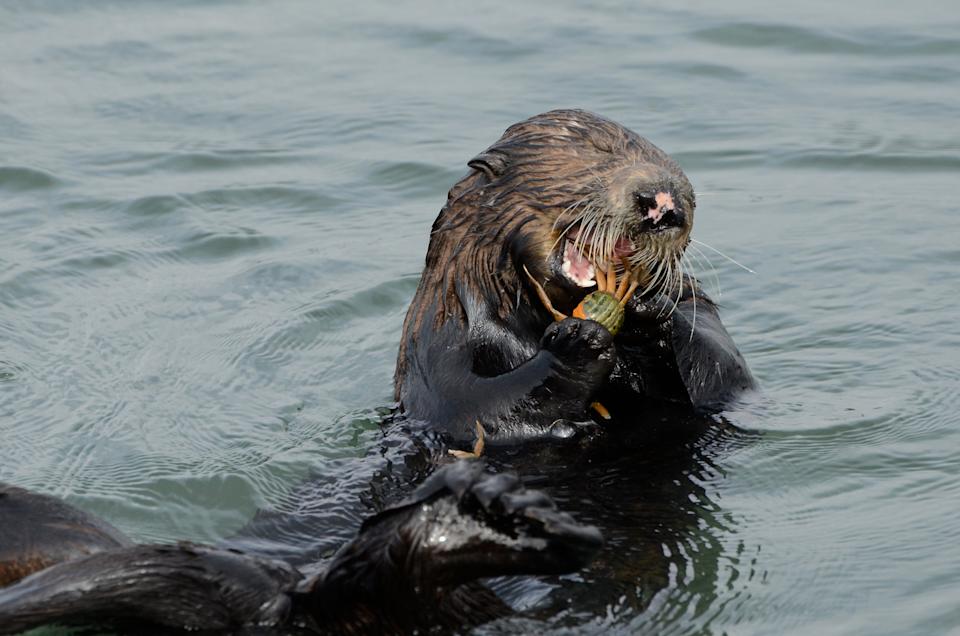SAN FRANCISCO – A California ecosystem has gotten an enormous enhance from an lovely, fluffy and hungry good friend.
At Elkhorn Slough Nationwide Estuarine Analysis Reserve, a newly-reinvigorated inhabitants of native southern sea otters has eaten so many invasive European inexperienced crabs that researchers say the otters have regionally solved an issue that has plagued the West Coast for years.
States are spending tens of millions to guard their inland waterways from the tiny crabs. Although small – they attain solely 4 inches in width – the invaders hurt native wildlife and shoreline ecosystems. At stake are multi-million greenback shellfish industries for Dungeness, king crab and different species.
However on the reserve, otters have nearly wiped the crabs out, serving to the estuary’s ecosystem come again into stability.
“The otters are a simply tremendous voracious predator,” mentioned Kerstin Wasson, analysis coordinator with the Reserve. “We calculated that the present otter inhabitants right here eats someplace between 50,000 and 120,000 inexperienced crabs a 12 months.”
Inexperienced crabs are initially from Europe and arrived on the West coast someday within the Eighties. They’re thought-about one of the crucial invasive species within the marine surroundings, destroying seagrass, devouring child crab and salmon and principally laying waste to coastal waters from California to Alaska.
Alaska has an early detection and response plan in place. Washington has allotted $12 million to battle the invaders, Oregon encourages crabbers to reap as much as 35 of them a day.
In California, researchers from the College of California, Davis spent years making an attempt to eradicate them from the state’s Stinson Seaside’s Seadrift Lagoon, solely to have them bounce again with a vengeance.
A sea otter eyes its lunch, considered one of two invasive European inexperienced crabs it was capable of retrieve underwater. Picture taken in 2011 in Moss Touchdown, CA.
However researchers in California’s Elkhorn Slough (pronounced “slew”) have been watching the invasion for 20 years they usually observed one thing shocking.
“In 2000, the inexperienced crabs had been fairly considerable,” mentioned Wasson. After which over the previous ten years, they began to vanish.
A couple of issues had occurred in that point. The water within the seven-mile-long tidal estuary on Monterey Bay acquired cleaner. Native eelgrass beds had been restored. The pure tidal change of water and marshes started to be restored.
And the ocean otters got here again.
Southern sea otters alongside the West coast had been hunted nearly to extinction for his or her thick, tender fur, solely gaining safety in 1913 when California declared them a “absolutely protected mammal.” Even that did not cease them from being hunted. Additionally at hazard from oil spills, which robbed them of the flexibility to remain heat, the variety of sea otters is believed to have declined to as few as 50 people down from as excessive was 300,000.
However by then it was nearly too late. Southern sea otters had been considered extinct till the early 1900s. Then a tiny remnant inhabitants was discovered surviving in Bixby Cove close to Massive Sur in 1914, web site of the now Instagram well-known Bixby bridge. The otters had been listed as threatened and named a protected federal species in 1977.
From that small group they’ve begun a gradual comeback.
A southern sea otter consuming a feminine inexperienced crab carrying orange eggs at Elkhorn Slough close to Monterey Bay in California
The primary male sea otter arrived within the Elkhorn Slough, 35 miles north of Bixby Cove, within the late Nineties. Solely within the early 2000s did females arrive, and shortly thereafter pups, mentioned Wasson.
The Monterey Bay Aquarium’s sea otter rehabilitation program additionally launched 37 pops into the Slough, serving to create a thriving and sturdy neighborhood.
Right now, the estuary is dwelling to greater than 120 otters and is the one one alongside the West coast that has been considerably colonized by southern sea otters.
And so they like to eat inexperienced crabs.
“Different marine mammals like seals have blubber to maintain them heat. However sea otters haven’t got blubber, so that they should eat an infinite quantity of meals every single day,” mentioned Wasson. Whereas clams are their most well-liked meals, the sinuous sea creatures had been more than pleased to chow down on the crabs.
As they did, a constructive suggestions loop started, what biologists name a trophic cascade.
“The otters consuming the crabs benefited the eel grass, which contributed to higher water high quality” which helped the otters, mentioned Rikke Jeppesen, an estuarine ecologist with the Elkhorn Slough Nationwide Estuarine Analysis Reserve who was the lead creator a paper printed December 10 in regards to the otters.
The paper reported the welcome information that over the previous decade, the Elkhorn sea otters have considerably decreased the influence of the worldwide invaders.
“Again within the early 2000s, we’d someday catch as much as 100 inexperienced crabs in a single lure. Once we set the traps in the identical place at this time we’ll get beneath ten and sometimes not even 5,” Jeppesen mentioned.
Inexperienced crab abundance was constantly lowest in Elkhorn Slough, the one California estuary with sea otters, the paper printed within the journal Organic Invasions discovered.
Therapeutic the ecosystem so the otters might come again had the win-win impact of serving to handle an invasive species. “The ocean otters, they’re like an assistant supervisor for us,” she mentioned.
The sample is placing.
“When the otter inhabitants was the bottom again in 2003-2004, we thought the inexperienced crabs had been going to take over Elkhorn Slough.”
“After which they did not” she mentioned. “And for that we thank the otters.”
The Elkhorn Slough, a tidal estuary in California’s Monterey Bay. It’s dwelling to a rising, wholesome inhabitants of southern sea otters, which had been nearly hunted into extinction by the early a part of the 1900s.
This text initially appeared on USA TODAY: Cute, hungry otters gobble up invasive inexperienced crabs in California


